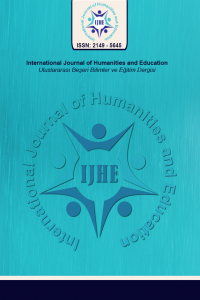Community of Practice: Supporting EFL Pre-Service Teachers in Conflict Resolution
Community of Practice, Online Communities of Practice, Conflicts among Students, ; EFL Pre-service Teachers
___
- Alony, I., & Jones, M. (2008). Blogs – the new source of data analysis. Journal of Issues in Informing Science and Information Technology, 5, 433-446.
- Barsky, A. (2007). Conflict Resolution for the Helping Professions. Oxford University Press.
- Birmingham, P., & Wilkinson, D. (2003). Using Research Instruments: A Guide for Researchers. RoutledgeFalmer.
- Block, H. (2010). Community-building in secondary ESL classrooms. Vanderbilt University, Nashville, Tennessee.
- Cambridge, D., Kaplan, S., & Suter, V. (2005). Community of practice design guide: A step-by-step for designing & cultivating communities of practice in higher education. Retrieved from https://library.educause.edu/resources/2005/1/community-of-practice-design-guide-a-stepbystep-guide-for-designing-cultivating-communities-of-practice-in-higher-education
- Creswell, J. W. (2014). Research design: qualitative, quantitative, and mixed methods approaches (4th Ed). Thousand Oaks, California: SAGE Publications.
- Duncan-Howell, J. (2007). Online communities of practice and their role in the professional development of teachers (Ph.D. thesis). Queensland University of Technology, Brisbane, Australia.
- El Masry, T., & Mohd Saad, M. (2018). On the cultivation of their community of practice: A case study of EFL Malaysian PreService teachers. The Qualitative Report, 23(4), 952-977.
- García-Raga, L., Grau, R., & López-Martín, R. (2017). Mediation as a process for the management of conflict and the improvement of coexistence in educational centres. A study based on the perceptions of secondary school students. Procedia - Social and Behavioral Sciences, 237, 465 – 470.
- Gibbons, K. (2010). Circle justice: A creative arts approach to conflict resolution in the classroom. Art Therapy: Journal of the American Art Therapy Association, 27(2), 84-89.
- Gossen, D. (2004). Restitution I Handout. Retrieved from https://www.nesacenter.org/uploaded/conferences/SEC/2012/spkr_handouts/Hargrave_Restitution.pdf
- Jacobs, J., & William, J. (2004). Exploring the use of blogs as learning spaces in the higher education sector. Australasian Journal of Educational Technology, 20(2), 232-247.
- Kong, S. (2018). Community of practice: An effective way to ESL teacher professional development in vocational colleges. English Language Teaching, 11(7) p158.
- Mahrous, D. S. (2015). Building a community of practice for English-as-a-foreign language tutors during private tutoring (Master thesis). California State University, San Bernardino, San Bernardino, U.S.
- Munarriz-Diaz, R., & Castañeda, M. (June, 2013). Cultivating a community of practice among student teachers and cooperating teachers. In M. S. Plakhotnik & S. M. Nielsen (Eds.), Proceedings of The 12th Annual South Florida Education Research Conference (pp. 142-148). Miami: Florida International University.
- Oladosu, B., & Rashidat, A. (2014). Organizational conflicts: Causes, effects and remedies. International Journal of Academic Research in Economics and Management Sciences, 3(6), 118-137.
- Shahmohammadi, N. (2014). Conflict management among secondary school students. Procedia - Social and Behavioral Sciences, 159, 630-635.
- Smeltzer, C., & Erb, P. (2018). Making amends: A restorative justice approach to classroom behavior. Teacher Educators' Journal, 11, 91-104.
- Trofymenko, S. (2000). The Importance of community building in the EFL classroom (Master thesis). The School for International Training, Brattleboro, Vermont.
- Tschannen-Moran, M. (2001). The effects of a state-wide conflict management initiative in schools. American Secondary Education, 29 (3), 2-32.
- Wenger, E. (2010). Communities of practice and social learning systems: The career of a concept. In Blackmore, C. (Editor) Social Learning Systems and communities of practice. Springer Verlag and the Open University.
- Wenger, E., McDermott, R. A., & Snyder, W. (2002). Cultivating communities of practice: A guide to managing knowledge. Brighton, MA: Harvard Business Press.
- Başlangıç: 2015
- Yayıncı: Halil TURGUT
Community of Practice: Supporting EFL Pre-Service Teachers in Conflict Resolution
Kadriye KAYACAN, Münevver ÖZLÜLECİ, Ayşegül ARSLAN
PEÇENEK-OĞUZ KÖKENLİ ÇITAK TÜRKLERİNİN DİLİ ÜZERİNE
Diyarbakır ve Çevresinin Hilafetin Kaldırılmasına Karşı Verdiği Tepkiler Üzerine Bir İnceleme
Türk Hazır Giyim Sektöründe Müşteri Temsilcisi
ÂŞIK SEYRÂNÎ’NİN KUŞLAR DESTANI ÜZERİNE AYRINTILI BİR İNCELEME
19 .Yüzyıl Osmanlı Devlet Adamı Bâbânzâde Mustafa Zihni Paşa’nın Hayatı ve İlmî Kişiliği
Selvi Boylum Al Yazmalım Filminin Göstergebilimsel Yöntem Bilimiyle Analizi
